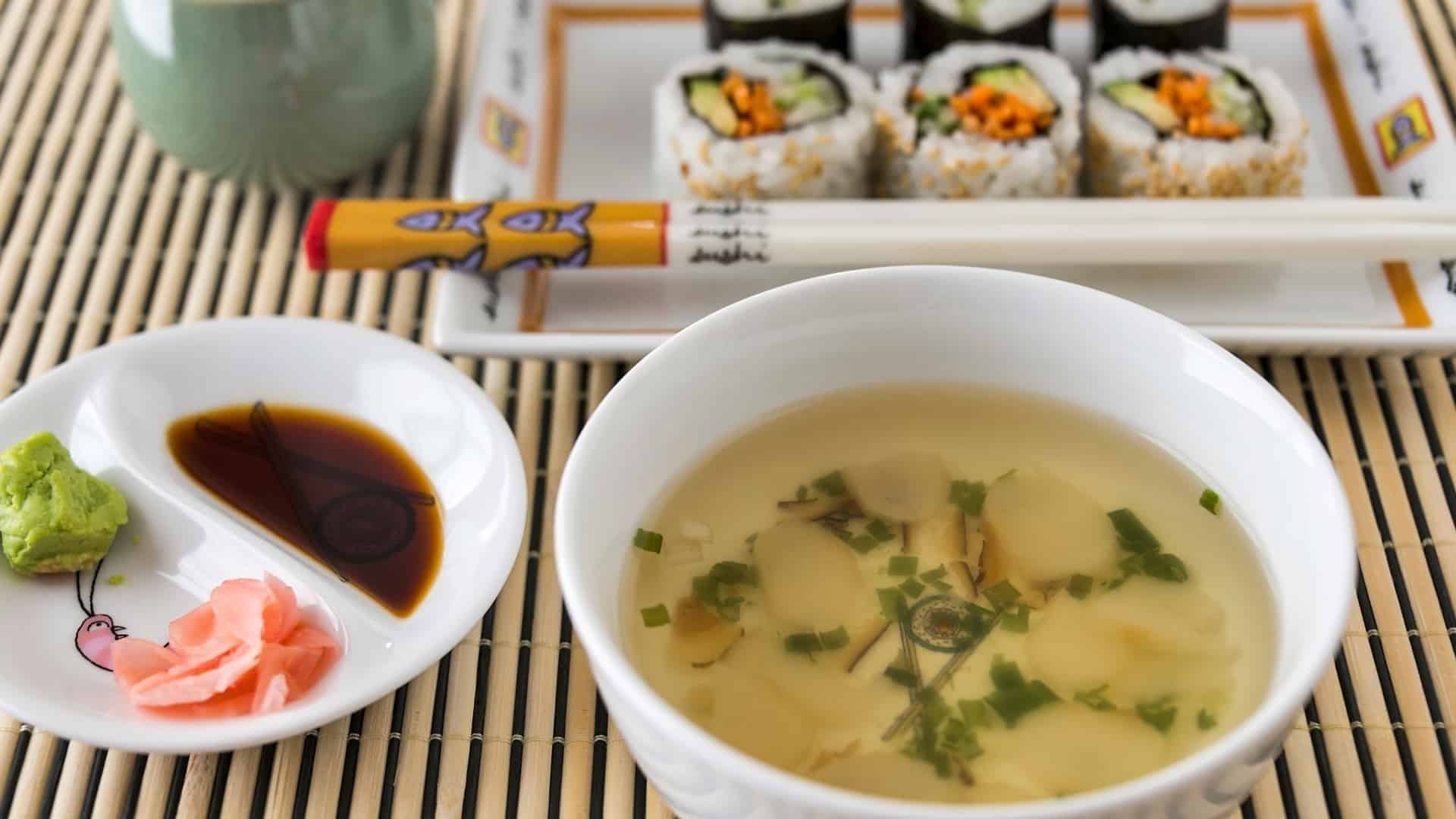Miso soup vs clear Japanese soup broth: What’s the difference?
In Japanese culture, there are a lot of soups they drink that go along nicely with their meals. They’re especially nice on cold rainy days!
One soup you might’ve heard of is miso soup. Miso soup broth uses miso paste (fermented soybeans), dashi (fish or seaweed stock), and vegetables.
There’s also Japanese clear soup, which is also known as “Miyabi soup”. You simmer meat stock and vegetables together to create Miyabi stock!
The key ingredients used to make each dish change its appearance. The miso paste found in miso soup gives the dish an almost opaque coloring.
The chef preparing Miyabi removes the vegetables after the stock simmers, giving the soup a clear broth and its nickname “clear Japanese soup”.

Both soups use vegetables in their stocks and green onions in their garnish. However, the depth of flavor is much richer in miso soup. Miso paste adds umami to the soup that clear Japanese soup doesn’t have.
Additions to each broth further differentiate between these 2 classic soups.
Miso soup traditionally includes tofu and green onions. It’s also common to add other vegetables, such as mushrooms, carrots, and onions. Some people even add noodles!
Miyabi soup generally includes only thin slices of mushrooms and green onions.
Read on to see which traditional Japanese soup fills your cravings.

Check out our new cookbook
Bitemybun's family recipes with complete meal planner and recipe guide.
Try it out for free with Kindle Unlimited:
Read for freeIn this post we'll cover:
How are miso soup and Miyabi soup used?
Japanese restaurants frequently serve both miso soup and Miyabi soup as options for appetizers. A colloquial name for Miyabi is “hibachi soup” because of its prevalence at hibachi restaurants. Miso soup is easier to serve as a standalone dish because its use of tofu and flexibility of adding vegetables makes it a heartier soup.
Japanese people will also drink miso soup for breakfast. Both soups are excellent to pair with rice and vegetables.
While people drink miso soup as a meal, Miyami soup acts better as a side dish or appetizer for the rest of the meal.
Also read: what to expect at a hibachi buffet
Nutritional difference between miso soup and clear Japanese soup
Both soups are excellent choices if you’re watching your calorie intake. Depending on the preparation of each soup and the vegetables added, the calorie count may change.
However, the average serving of Miyabi soup contains about 47 calories. The average serving of miso soup (prepared with tofu and green onions) is about 90 calories.
Because both soups are prepared with meat stocks, both do have some protein content. If you’re looking to add more protein though, miso soup tends to have about 2g more protein per serving (6g/serving) than Miyabi soup (4g/serving).
Miso soup and Miyabi soup are both low sources of cholesterol, so they can be great additions to your diet. Both soups also include vitamins from the vegetables in their stock, such as vitamin K.
Both soups can be high in sodium. So if you’re watching your salt intake, you may want to watch how much soup you drink, or prepare it carefully to minimize how much sodium you get.
Health benefits of each soup
People looking to diet or watch their weight often turn to both miso soup and Miyabi soup. However, the health benefits of including these broths in your diet aren’t just limited to weight loss alone.
Here are some other health benefits you can get from drinking these soups!
Miso soup
Miso soup is relatively low in fat. Low-fat foods have been shown to benefit the pancreas and prevent heartburn.
The soybeans used in most miso pastes contain the necessary amino acids for human health, so miso soup can be a substitute for meaty dishes.
Studies have also shown that miso soup is beneficial for digestion. The fermentation process for the soybeans in miso paste adds good bacteria like probiotics, which will help your gut keep functioning well.
The fermentation process used in miso soup makes the soup rich in antioxidants. Antioxidants diminish free radicals in your cells, which can, in turn, lead to better heart health.
Miyabi soup
Miyabi soup is cholesterol-free. Low-cholesterol foods are exceptional choices for your arteries and your heart.
In addition to these benefits, Japanese clear soup is low in fat, much like miso soup. This means Miyabi soup is also unlikely to cause heartburn.
Japanese clear soup is very easy on the stomach, so if you’re recovering from an illness, it’s a great option to gently sustain you. Furthermore, the warming property of the soup can help battle sickness.
The antioxidants found in this soup stock make it a great choice to fight inflammation. If you’re bloated, try a cup of Miyabi soup.
Miyabi soup is a good source of water and fiber. While it may not contain as much protein as miso soup, it can be a great way to start a meal while boosting your hydration and fiber intake.
Which soup should you drink?
Both soups are excellent additions to a Japanese meal, so either one would be a marvelous side dish with rice and stir-fried vegetables or meat. If you’re looking for a soup to stand by itself as a meal, miso has more protein and nutrients. But if you’re looking for a light, fiber-packed appetizer, Miyabi soup might be more up your alley.
Also read: check out this delicious beef misono, Tokyo style
Check out our new cookbook
Bitemybun's family recipes with complete meal planner and recipe guide.
Try it out for free with Kindle Unlimited:
Read for freeJoost Nusselder, the founder of Bite My Bun is a content marketer, dad and loves trying out new food with Japanese food at the heart of his passion, and together with his team he's been creating in-depth blog articles since 2016 to help loyal readers with recipes and cooking tips.
